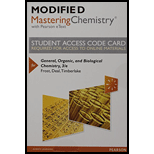
Concept explainers
a.
To classify:
The given
Introduction:
The chemical reaction is the process in which one or more reactant molecules react to form one or more products. Every chemical reaction is associated with a chemical change which is due to the difference in energy of reactants and products.
b.
To classify:
The given chemical reaction as a reversible or irreversible reaction.
Introduction:
The chemical reaction is the process in which one or more reactant molecules react to form one or more products. Every chemical reaction is associated with a chemical change which is due to the difference in energy of reactants and products.
c.
To classify:
The given chemical reaction as a reversible or irreversible reaction.
Introduction:
The chemical reaction is the process in which one or more reactant molecules react to form one or more products. Every chemical reaction is associated with a chemical change which is due to the difference in energy of reactants and products.
Want to see the full answer?
Check out a sample textbook solution
Chapter 5 Solutions
Modified Mastering Chemistry with Pearson eText -- Standalone Access Card -- for General, Organic, and Biological Chemistry (3rd Edition)
- For each of the following reactions, determine if the ΔS° is a positive or a negative value:arrow_forwardAt equilibrium, the free energy of the reactants is equal to the free energy of the products. true or falsearrow_forwardIs CaCl2 (aq) + Na₂CO₃ (aq) → CaCO3 (s) + 2NaCl (aq) reversible or irreversible reactionarrow_forward
- A chemical interaction in which the products contain less free energy than the reactants is called a(n) ____ reaction.arrow_forwardBased on the relative ΔG‡ values for the forward and reverse reactions (and assuming we haven’t added a lot of heat energy into the system) is this SN2 reaction reversible or irreversible?arrow_forwardSelect the reactions in Figure 39 that can be represented by the accompanying energy diagram? * Reaction A Reaction B Reaction Carrow_forward
- Mark the reaction or reactions in Figure 10 that are possible. * 1- A 2- B 3- C 4- Darrow_forwardThe standard free energy change for the reaction CH4(g)+2O2(g) -> CO2(g) + 2H2O(l) is -194.8 kcal at 25ºC and -191.82 kcal at 75ºC. Calculate the heat of reaction at 25ºC.Ans: -212.6 kcalarrow_forwardIn each of the following three reaction coordinate diagrams, state: (a) Whether the reaction is exothermic or endothermic. (b) Whether the reaction is the slowest, the fastest, or intermediate in rate. (c) If all three reactions have the same entropy change between the reactant and product, which reaction has the largest favorable G0.arrow_forward
 Living By Chemistry: First Edition TextbookChemistryISBN:9781559539418Author:Angelica StacyPublisher:MAC HIGHERChemistry: Matter and ChangeChemistryISBN:9780078746376Author:Dinah Zike, Laurel Dingrando, Nicholas Hainen, Cheryl WistromPublisher:Glencoe/McGraw-Hill School Pub Co
Living By Chemistry: First Edition TextbookChemistryISBN:9781559539418Author:Angelica StacyPublisher:MAC HIGHERChemistry: Matter and ChangeChemistryISBN:9780078746376Author:Dinah Zike, Laurel Dingrando, Nicholas Hainen, Cheryl WistromPublisher:Glencoe/McGraw-Hill School Pub Co
 Chemistry for Today: General, Organic, and Bioche...ChemistryISBN:9781305960060Author:Spencer L. Seager, Michael R. Slabaugh, Maren S. HansenPublisher:Cengage Learning
Chemistry for Today: General, Organic, and Bioche...ChemistryISBN:9781305960060Author:Spencer L. Seager, Michael R. Slabaugh, Maren S. HansenPublisher:Cengage Learning Organic ChemistryChemistryISBN:9781305580350Author:William H. Brown, Brent L. Iverson, Eric Anslyn, Christopher S. FootePublisher:Cengage Learning
Organic ChemistryChemistryISBN:9781305580350Author:William H. Brown, Brent L. Iverson, Eric Anslyn, Christopher S. FootePublisher:Cengage Learning





